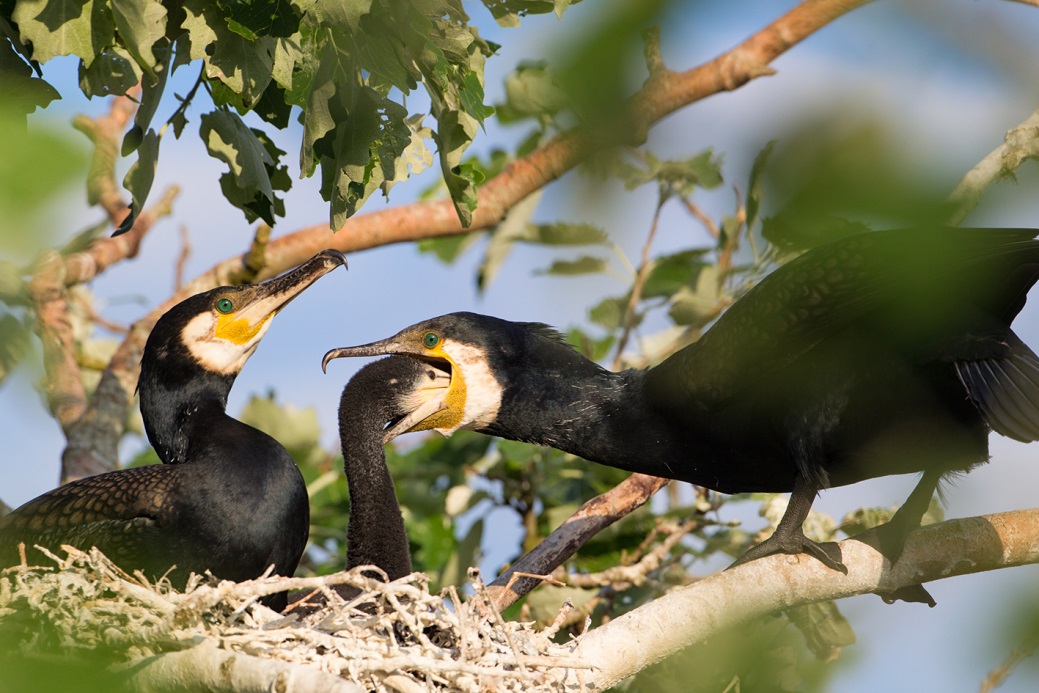Pan-European status of the breeding population of Great Cormorants published
Results from a major survey of breeding numbers of cormorants in Europe have just been published, providing the most complete overview of the breeding distribution and abundance of these fish-eating birds ever compiled.

Numbers of cormorants have increased markedly across Europe, particularly within the last three decades. This rapid population growth was apparently the result of both increased survival and improved breeding success from the combined effects of protection from persecution in breeding colonies, protection against shooting, a decrease in the use of pesticides, and increased abundance of small fish in many European waters, partly as a result of nutrient enrichment.
The expansion in the cormorant population has led to significant conflicts with recreational and commercial fisheries and fish farms in many parts of Europe. For this reason, on the basis of concerns expressed by the various affected social and economic interests, the European Commission decided that one action should aim at increasing current knowledge about the status, trends and distribution of the Great Cormorant throughout Europe. This information was judged as being fundamental to support the resolution of these conflicts throughout the European Union. As a consequence, the Commission initiated the ‘CorMan’ project, chaired by Thomas Bregnballe (DCE, Aarhus University in Denmark) and David Carss (Centre for Ecology & Hydrology in the UK).
Monitoring
During 2012-2013 the CorMan project has collaborated with the IUCN/Wetlands International Cormorant Research Group and a large number of organisations and individuals in Europe, in order to monitor the breeding and wintering population of cormorants.
The results from the counts at breeding colonies have now been published as a Scientific Report from the DCE - Danish Centre for Environment and Energy and as an IUCN/Wetlands International Cormorant Research Group Report.
The report gives the European Commission, decision-makers, fisheries organisations, conservationists and researchers an updated overview of where cormorants are breeding and how their numbers have changed since 2006. It also includes detailed national and sub-national descriptions of the breeding populations in 32 of the countries that participated in the counts.
Numbers
The report shows that 370,000 pairs of the continental sub-species Phalacrocorax carbo sinensis were breeding in the Western Palearctic, which covers Europe (west of the Ural Mountains), North Africa and parts of the Middle-East, of which 214,500 pairs bred in the 28 EU Member States. Highest densities of this sub-species were found around the Baltic Sea (167,700 pairs), in The Netherlands (23,600 pairs) and around the Sea of Azov and the western and northern part of the Black Sea (82,000 pairs).
Compared with 2006 total breeding numbers had remained stable in the Baltic Sea and The Netherlands whereas numbers had increased in some parts of central and southern Europe and in the north-eastern part of the Black Sea. Declines were recorded in the north-western part of the Black Sea, including the Danube Delta.
The breeding population of the Atlantic sub-species P. c. carbo was estimated at 42,500 pairs, with Norway as the most important breeding area. The breeding population of this sub-species had declined markedly in Norway between 2006 and 2012.
Senior researcher Thomas Bregnballe of DCE said,
“This survey was conducted by more than 1200 people and confirms the Baltic Sea as the most important cormorant breeding area. It is in this corner of Europe that breeding numbers have expanded most dramatically. However, within the last six years, numbers have declined in the western Baltic and the increase in the eastern part has levelled off. People in central and southern Europe have experienced increasing cormorant numbers over the years as more and more birds have migrated south during autumn to stay in warmer climates during winter. However, in the last 25 years some of these birds have settled to breed in former wintering areas and formed new colonies there. As a consequence breeding numbers are now increasing in a number of more southern countries such as France, Spain and Italy.”
Contact: Senior researcher Thomas Bregnballe, tlf. +45 8715 9017, tb@dmu.dk
DCE – Danish Centre for Environment and Energy
Department of Bioscience, Aarhus University
Breeding numbers of Great Cormorants Phalacrocorax carbo in the Western Palearctic, 20122013. IUCN-Wetlands International Cormorant Research Group Report. Bregnballe, T., Lynch, J., Parz-Gollner, R., Marion, L., Volponi, S., Paquet, J.-Y., Carss, D.N. & van Eerden, M.R. (eds.) 2014. Aarhus University, DCE – Danish Centre for Environment and Energy, 224 pp. Scientific Report from DCE – Danish Centre for Environment and Energy No. 99
Additional information
Summary information from the report will be disseminated further under the EC CorMan (‘Sustainable Management of Cormorant Populations’) project which is also developing an EU Cormorant Platform
